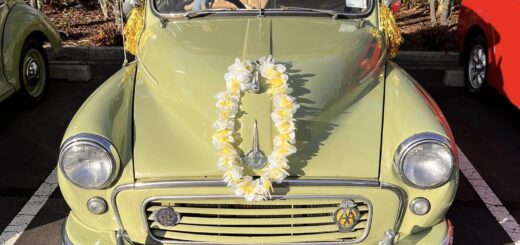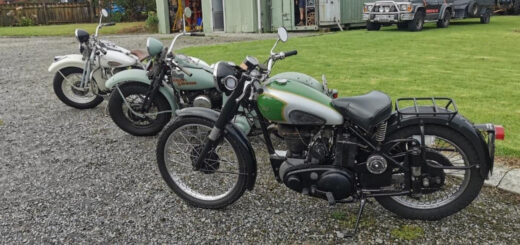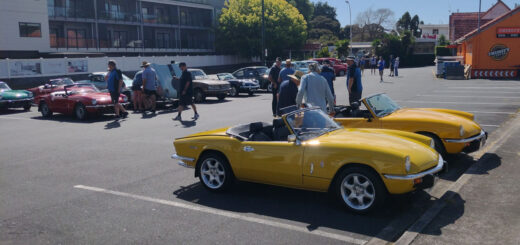Model Development
There were three main periods spanning nearly 25 years. The Series MM, produced between 1948 and 1952 was powered by the same side-valve engine as seen in the pre-war Morris Eight. The Series II gained the overhead valve engine of the Austin A30 in 1953 after the merger with Morris creating the British Motor Corporation. The Minor came of age in with the 1000 when the new 948cc was fitted and eventually ending up with the 1098cc engine in 1962.
Although all models have their enthusiasts, it would be reasonable to suggest that the Minor 1000s are the most popular, although the early side-valve models have collector appeal. The 803cc-engined vehicles are probably the least popular because the Austin engine was not exactly a ball of fire and the gearbox fitted to this model was a little fragile. Many Series 2 cars have been fitted with transplanted 948cc engines and gearboxes over the years, to improve their performance and reliability.
At first glance, all Minors look much the same, the main differences being the position of the headlamps which were originally fitted low down in the radiator grille in the earliest `low light’ models. To comply with US regulations, headlamps were fitted in the guards from 1950 onwards (1949 for cars exported to USA). A curved one-piece windscreen replaced the two-piece flat version with the introduction of the 1000 in 1956, the rear edge of the bonnet changed as a result. At about this time, the mesh-type grill was replaced by a slatted type, the rear window was made larger and the instrument panel was redesigned.
The passenger models were two- and four-door saloons, a convertible and an estate called the Traveller, often referred to affectionately as the `Woody’. Commercials included 5cwt vans (popular with the British GPO) and utility versions, as well as many specially bodied vehicles built by after-market body builders.
MAJOR MINOR ACCIDENTS
A few months ago the UK Minor Monthly magazine ran an article on the safety of Minors. While this was interesting the only really hard information was that Minors did not seem to be overly represented in accident statistics although they probably weren’t as safe as modern cars. This got me thinking and I wondered how a Minor might actually perform in an accident, especially a head on collision.
Firstly I must stress that I am not a mechanical engineer and have only limited knowledge of the behaviour of cars in collisions, I have simply tried to apply some basic engineering to a knowledge of the construction of the Minor.
The front of the Minor can be divided into two parts, the “chassis” rails are the main structural members and carry the engine and suspension loads. Above this are the front flitch plates, the front mudguards, radiator surround and the bonnet. At the rear of the engine bay the main bulkhead (Firewall) has a strong cross member at the shock absorber level.
Generally I would expect that the chassis rails will be relatively rigid while the flitch plates etc will be quite soft and “squishy”.
So what might happen if the car hits something? This will depend on the height of what is hit. If it is something like the rear of a truck that allows the chassis rails to go under it I would expect the radiator surround, guards etc to provide a reasonably soft crumple zone like a modern car. This should deform until the engine is pushed off its mounts and back into the firewall. The engine is then likely to drop out of the bottom of the car and probably push the back of the gearbox up into the passenger compartment and possibly sideways. Except for the gearbox thrashing around I would expect a Minor to perform reasonably well in this situation.
However in what is a more likely accident, if the chassis rails hit an object they are likely to be rigid and provide a “sudden stop” with only limited deformation. This is akin to jumping onto concrete instead of a mattress and reducing this effect is a large part of modern car design. Added to this is the lack of internal padding in the passenger compartment that leaves lots of hard surfaces for a person to hit during the sudden stop.
I would guess that the performance would be somewhere between a modern saloon and a full chassis four wheel drive.
The other feature of modern car design is the “safety cell” provided by the passenger compartment. In this the Minor looks quite promising as the aim is to produce a rigid compartment that doesn’t deform and trap people. The beam across the front bulkhead is quite strong and should support the front of the compartment quite well. The sill structures below the doors when in good condition (they are very rust prone) are very strong and combined with the heavy doors should give quite good side intrusion protection.
Overall I would not expect a Minor to be as safe as an equivalent size modern car but would probably perform better than many of it’s contemporaries.
So what can you do to improve it? Well, not a lot as most of the safety is designed in and cannot be readily altered other than to ensure that the car is structurally sound. Fitting seat belts is an obvious (and normally required) addition.
CLASSIC INSURANCE
If you haven’t already heard about classic insurance for your Morris it is well worth investigating.
Classic Insurance is specifically designed for classic cars that are not used as everyday vehicles and recognises that these cars are relatively low risk. You will find that premiums are typically less than 1/2 the cost of ordinary cover and often will be less than third party only policies. For example I had a 1965 M1000 insured for $4000.00 on an ordinary policy costing over $300.00 per year. This dropped to $130.00 on a classic policy and I have recently got it down to $75.00. This is less than a third party policy on a Mini of $95.00 with the same company.
In order to keep the premiums down on the classic policies there are a number of conditions, the most common ones are:
(1) You must be a member of a recognised car club and you have to have been a member before applying for the insurance. (AMMCC seems to fit the bill for this)
(2) There are limits on the total mileage the car can run per year, this is generally 3000 miles although some companies will extend this to 5000 at extra cost.
(3) The car must be kept in a secure garage.
(4) Usually the car can be driven only by named drivers and generally no under 25yr old’s.
(5) Some of the companies will want you to have a “modern” insured with them as well so they can see that the classic car is not a daily runner.
The three main suppliers of classic insurance that I know of are
AA Insurance.
Mark Joblin Insurances.
Gary Mooney Insurances.
ROUTINE MAINTENANCE
[Spreading the Work] [Lubrication] [Occasional Attentions]
Regular maintenance which implies both lubrication and routine servicing is the best insurance against early repair bills. In the case of the Minor, the official service scheme calls for attention at intervals of 1000, 3000, 6000 and 12000 miles. There is a considerable body of technical opinion, however, to support the contention that most manufacturers’ lubrication charts err on the side of safety, necessarily making allowance for the owner who tends to postpone routine servicing to the last minute: provided that maintenance is carried out conscientiously, the periods between the various jobs can, in many cases, be appreciably extended. On a car in good condition, for example, it should not be necessary to lubricate the various chassis points more frequently than at 2000-mile intervals unless it is operating under very adverse conditions of heat and unsurfaced roads, or continuous mud and slush; similarly, the use of modem engine oils and efficient oil filters should enable an oil change to be deferred until 5,000 miles have been covered. At least one major car manufacturer has simplified his maintenance schedules by grouping the jobs under 2,000 and 5,000-mile headings and the owner of a Minor could rearrange his schedule on similar lines, by carrying out the 1000-mile service at 2000-mile intervals, combining the 3000-mile and 6000-mile schedules in one 5000-mile service and deferring the 12000-mile items to 15000 miles, including, of course, the 5000-mile jobs that would then become due.
Spreading the Work.
Anyone who carries out the work at home, on the other hand, will quickly discover the shortcomings of any conventional system of maintenance when he finds, for example, that at the official 6000-mile service there are 31 jobs to be done and that the work may well take up the better part of a full weekend! There is a lot to be said, therefore, for spreading the load by making a list of all the items that require attention and incorporating these in a chart in such a manner that two or three jobs can be done comfortably once a week say, during the course of an hour or so on a Saturday. The manner in which this is arranged will, of course, depend on the average weekly mileage but it is not difficult to devise a programme which will ensure that every item will recur at the appropriate period say, once in every 5, 10 or 20 weeks, as the case may be.
A further advantage of such a system is that it is flexible; if mileage should accumulate unexpectedly, it is a simple matter to bring the series of jobs forward by the appropriate amount. In practice, too, an enthusiastic owner usually spends a good deal of time at weekends or in the evenings on tuning and adjustments so that a number of items receive more frequent attention than was anticipated by the manufacturer when drawing up the servicing schedule.
A final point: only experience can show, of course, whether or not it is necessary to vary the inspection periods on a given car. For example, worn steering bushes, which are still serviceable, will allow grease to escape more quickly than closely-fitting bearings and will require more frequent lubrication. The same applies to a greater or lesser extent to other aspects of maintenance.
The points at which lubrication and other routine attentions are required, but the more specialized aspects of servicing are dealt with in chapters devoted to the individual components. It should be sufficient to deal here, therefore, with one or two general points that are not covered elsewhere.
The routine checks that cannot be tied down to a strict schedule should not be forgotten: the engine oil and water levels and tyre pressures, which should be made at frequent intervals, and always before starting out on a long run.
Service A
1. All nipples (except steering rack): lubricate.
2. Engine, gearbox and rear axle: top-up oil levels,
3. Carburettor piston dashpot: top-up.
4. Carburettor controls: lubricate.
5. Air cleaner: check oil level: remove sediment if necessary.
6. Battery: top-up cells with water; make hydrometer test if possible.
7. Brake fluid reservoir: check level of fluid.
8. Brake pipes and unions: inspect for leakage of fluid.
9. Shock absorbers: examine for leaks.
10. Tyre pressures: check.
11. Wheel nuts: check tightness.
Service B
Carry out items 1-10 and following additional work
12. Engine: change oil.
13. Sparking plugs: clean and adjust.
14. Water pump: remove plug, lubricate with a few drops of SAE 140 oil, replace plug. If nipple is fitted, apply grease gun (2-3 strokes).
15. Distributor: clean and adjust contact points; lubricate driving shaft, cam, and advance mechanism; check action of latter.
16. Dynamo driving belt: check tension.
17. Dynamo rear bearing: lubricate.
18. Clutch: check pedal free travel; adjust.
19. Door hinges, locks, etc.: lubricate.
20. Wheels: change round to even-out tyre wear.
Service C
Carry out items 1-20 and following additional work
21. Gearbox and rear axle: change oil.
22. Oil filter: fit new element.
23. Valve rockers: check clearances: adjust if necessary.
24. Carburettor and fuel pump: clean filters; check piston for freedom; check and if necessary adjust idling speed and mixture strength.
25. Front hubs: check condition of bearings and seals; repack with grease.
26. Trafficators: lubricate.
27. Door hinges and striker plates: check adjustment and tighten screws.
28. Rear springs: tighten securing bolts.
29. Brakes: check and adjust.
30. Front suspension: have height and steering geometry checked by Morris dealer.
31. Shock absorbers: check for leaks; top-up if necessary.
Service D
Carry out items 1-31 (except items 3 and 12) and following additional work
32. Steering gear: lubricate rack and pinion.
33. Engine: remove sump and clean oil intake filter; refill with new oil.
34. Carburettor: clean suction chamber and piston: top-up dashpot; remove and clean float-chamber.
35. Sparking plugs: as a precaution, fit new plugs.
36. Radiator: de-scale, drain, flush and refill.
37. Engine Test: make compression and vacuum tests to determine engine condition.
LUBRICATION
There are many arguments in favour of the practical owner carrying out routine lubrication himself. Only two items of equipment are required, apart from the usual hand tools: a pair of ramps, on to which the front or rear wheels can be driven in order to provide adequate clearance for working beneath the car (assuming that a pit is not available or trolley jack and axle stands); and a good high-pressure grease gun. Although the ordinary type of grease gun is quite efficient the side-lever type of gun that enables a very high pressure to be developed with little effort, and which has also the advantage of being fitted with a long extension tube making it easy to reach less accessible nipples, and a snap-on hydraulic connector which provides a perfect seal without the need for applying pressure against the nipple, is well worth its higher cost.
These items will render the owner virtually independent of a service station, and their cost will probably be more than recovered during the first few months of home servicing. There will be the added satisfaction of knowing that the work has been carried out conscientiously, that no greasing points have been overlooked or scamped and also that any signs of impending trouble have been detected in good time. Apart from a saving the do-it-yourself owner is also freed from the need for making an appointment to have his car serviced (sometimes weeks in advance) and being deprived of its use for the better part of a day while it awaits its turn for attention in a busy service station.
Chassis Lubrication.
The most suitable lubricant to use in the grease gun is one of the modern multi-purpose lithium-based greases, which are suitable not only for the steering connexions, swivel pins, propeller shaft nipples, brake cables and pivots, but- which also should be used for packing the front wheel hubs. Each grease nipple should be wiped before the gun is applied, to avoid any risk of grit being forced through the nipple into the bearing. If the nipple is dented or otherwise damaged it is a simple matter to unscrew it and fit a replacement. In an emergency, however, it is possible to obtain a satisfactory seal even on a damaged nipple if a piece of cheesecloth or other light fabric is first placed between the nipple and the end of the grease gun.
Many owners are unaware that every lubrication nipple contains a small spring-loaded ball valve which prevents the grease from escaping from the bearing. If a “worm” of grease exudes from the nipple when the grease gun is removed this valve is not functioning correctly and it is advisable to renew the nipple as soon as possible. It is an advantage, when greasing each steering swivel, to jack up that side of the car until the front wheel is clear of the ground. This will allow grease to reach the thrust faces of the bearings that carry the weight.
For oil-can attentions a good-quality light engine oil, or preferably an oil which has anti-rust properties, can be used in an oil can. Another excellent lubricant is an upper-cylinder oil which tends to prevent gumming. Such parts as the distributor automatic-timing mechanism should not be forgotten; the small weights housed within the distributor body greatly influence the whole behaviour of the engine and the power output, fuel consumption, and performance that will be obtained.
On parts such as door hinges and catches, surplus oil should be wiped off to prevent soiling of the driver’s or passengers’ clothes. A solidified lubricant, which is rather cleaner than ordinary oil, can be obtained for this purpose.
Gearbox and Rear Axle Lubrication.
Heavy oil should not be used in the gearbox. Engine oil of the same grade as that specified for the engine is the correct lubricant. The teeth of the hypoid gears in the back axle, on the other hand, are subject to much higher stresses and require an oil containing special additives to maintain an adequate film of lubricant between the working parts. However good this oil may be initially, it begins to lose some of its properties after a period of service and the axle must, therefore, be drained and refilled at the mileage specified in the chart. Moreover, it is not advisable to mix “extreme pressure” oils, as they are termed. The correct grade is SAE 90 EP. As the combined filler and level plug is at the side of the axle casing, it is rather an awkward job to inject oil unless a piece of rubber tubing is fitted to the spout of a forced-feed oil can. Alternatively, one of the inexpensive polythene oil cans obtainable from multiple stores, from which the oil is expelled by pressure on the sides of the container, will fill the bill admirably. Oil should be injected until it begins to overflow from
the hole. Wait until the drips have stopped before refitting the plug.
OCCASIONAL ATTENTIONS
Under this heading it is convenient to group those jobs to which it is difficult to assign any hard-and-fast mileage periods. Occasional checks and inspections are particularly valuable in enabling the owner to detect and forestall trouble. Small faults, which initially may only reduce efficiency, can lead in the end to more serious and expensive breakdowns. By keeping the engine clean, for example, oil leaks can be detected, while the removal of the accumulated road dust or oil from terminals and insulators will go a long way towards preventing leakage of electrical current especially high-tension current in damp or wet weather.
A careful inspection of the engine compartment, from time to time, will often reveal a loose nut or clip which might allow a cable to chafe, resulting eventually in a short-circuit.
The Fan Belt.
The fan belt, which also drives the generator, should be kept free from grease and should be correctly tensioned. There should be a free movement of one inch at the centre of the belt. If the belt is too slack, it will slip; on the other hand, if it is too tightly adjusted, excessive wear will occur on the fan and generator bearings. It is a simple matter to adjust the tension by loosening the two upper mounting bolts on the generator and the clamping bolt on the strut, allowing the generator to be swung towards or away from the engine. To increase the tension on the belt, lever the generator gently upwards with a short length of wood. After the mounting bolts have been tightened, re-check the free movement of the belt.
Clutch Adjustment.
As the friction linings, on the driven plate of the clutch, wear, the slight free movement that should exist at the clutch pedal will gradually be taken up. When all the free play has been eliminated there is a risk of the clutch beginning to slip under load, causing overheating and rapid deterioration of the linings. A free movement at the pedal of at least 1″ should be maintained by releasing the locknut and screwing the adjusting nut the required amount towards the front of the car. If the clutch does not free properly when the adjustment is correct the trouble must lie at some point within the clutch mechanism and will call for specialist attention. When clutch judder develops the most likely cause is worn or glazed friction linings, a defective centre-plate or internal release mechanism. Before deciding to have the clutch overhauled, however, check the adjustment of the engine tie-rod. The central hexagonal section should be adjusted so that the rod is neither in tension nor under compression when the end nuts are tightened with the engine at rest. The end nuts (which are self-locking) should not be pulled up too tightly as the rubber bushes are intended to give a certain amount of resilience.





